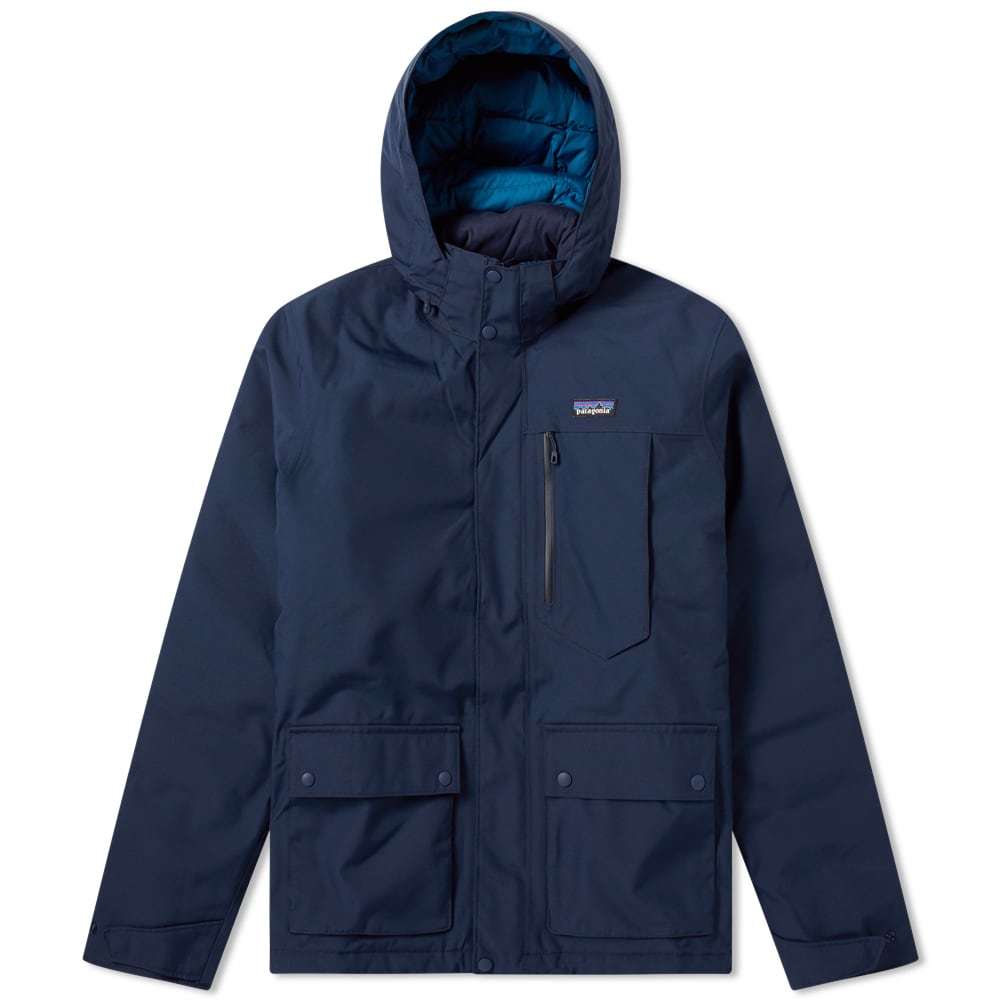
Moments after receiving it, my husband bestows his new Patagonia Topley Jacket with the highest compliment: “This is gonna be my new dude.” He wasn’t lying. This 100% recycled down jacket has quickly become Colton’s most beloved possession.
Am I surprised? No. Colton is a fantastically practical man. So a winter jacket that’s insulated and waterproof, stylish and tactical absolutely deserves to be his dude. It’s a one-and-done kind of purchase, and thus the ideal piece of outerwear for the man that once brought nothing but a small-sized backpack on a three-day trip. I honestly don’t understand the logistics of that, but I know it happened.
So what makes Patagonia Men’s Topley Jacket deserving of such a title? From the H2No® Performance Standard shell to the 700-fill-power recycled down insulation, this jacket is technically flawless. And that’s just the beginning.
In true Patagonia fashion, there’s a laundry list of sustainability-minded details that come along with it. We’ll get into all the touch points in this Patagonia Men’s Topley Jacket review.
Patagonia’s Topley Jacket Review
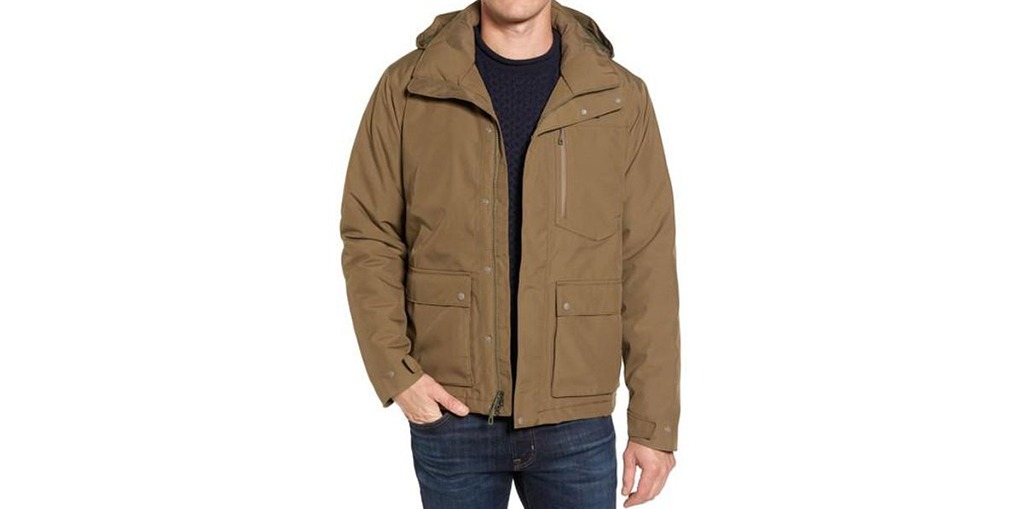
As we so often do, let’s begin with first impressions. The Topley Jacket arrived in a recyclable (and compostable!) paper bag. Simply wrapped, with minimal packaging. (Yay! No plastic waste!) For the performance it promises, the jacket was actually much more compact than expected.
The Topley is one of Patagonia’s rare men’s only jacket styles, and it shows. A regular-fit jacket with a casual hip length, spacious hood and two top-entry patch pockets, it gives off Carhartt style vibes, but with more technical features.
As much of Colton’s wardrobe, it lives squarely in the description of “not a piece of clothing, but a piece of equipment.” He immediately pours water on it to test the waterproof claims. The performance standard 2-layer shell and DWR (durable water repellent) finish do their job seamlessly, beading the water off the jacket and onto our carpet.
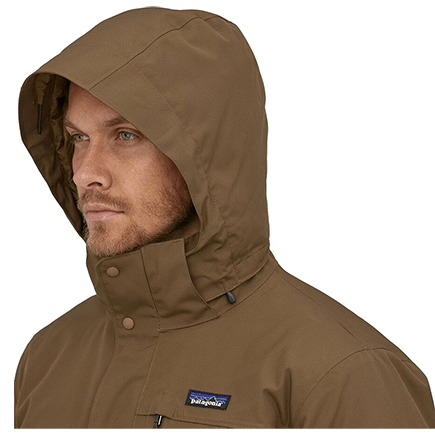
The size chart did us right and the large fits true-to-size. Although not quite a slim fit, the Topley still sits close to the body, offering total warmth and weather protection without any bulk.
Such functionality with no restriction to your range-of-motion? This immediately causes Colton to wax poetic on the potential of such a jacket. Chopping wood on a brisk morning. Pulling crab traps in the fog. Snow blowing the driveway after a storm. You know, normal stuff.
He admires the removable hood, zippered chest pocket and waterproof zipper. Even the microfleece collar gets a shout-out. Somehow, Patagonia has managed to fit every feature on his wish list into this jacket. And we haven’t even started on the stuff that makes this a worthwhile vote for your dollar.
Topley FAQs:
Heads up: this jacket is a durable, functional (and stylish) piece of equipment, so we are about to dive into some of the technical components this jacket brings to the table.
1. How warm is the Patagonia Topley Jacket?
The majority of the Topley Jacket’s warmth comes from 700-fill-power, 100% recycled down made from reclaimed duck and goose down products. Confused about fill power? It works more-or-less like this: the higher the fill power, the loftier, lighter and higher warmth-to-weight ratio of the jacket.
Usually, products will have somewhere between a 400-900 fill power. On the lower end of the scale, you get casual, everyday warmth as well as a casual, everyday price. As the fill power rises, so does the warmth-to-weight ratio and the cost.
A 700-fill-power jacket is considered a high-quality, mid-to-high warmth jacket. It’ll pack more than your average punch, keeping you cozy in cold—but not frigid—temperatures. (The Internet suggests layering it with a down sweater if temps drop real, real low.) So, snow flurries? Yes. Snow apocalypse? No. You might consider something like the Patagonia Better Sweater as an added layer.
While an exact temperature rating would be nice, Patagonia is careful not to put an objective label on a very subjective thing. If you run cold, 700-fill-power down might not be enough. If you run warm, 700-fill-power might feel like a furnace.
As if the down insulation wasn’t enough, Patagonia adds plenty of crafty weather-proof features to help you keep the cold, wet, and windy elements at bay. A two-layer, 100% recycled polyester shell with a DWR finish and a 50-denier, plus a 100% recycled polyester ripstop lining with a DWR finish makes this bad boy immensely waterproof. The two work together to seal out moisture and protect that soft, warm down from getting damp.
An insulated, adjustable hood and drop-tail hem seal out cold air while side-entry handwarmer pockets to keep the mits warm. The warmth meter keeps rising thanks to an external storm flap on the center-front zipper and a warm, microfleece-lined collar.
2. How does the Patagonia Topley Jacket fit?
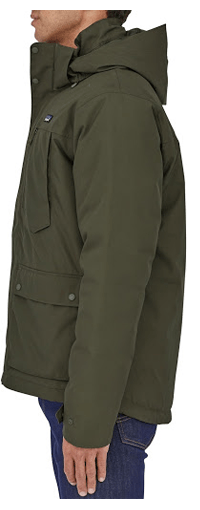
The high-performance details of the Topley Jacket allow it to be hyper-warm and weather-proof without any extra bulk. This, of course, is a major perk of purchasing a top-of-the-line product like you’re getting with the Topley.
We found the sizing accurate. The large was a large and fit Colton’s over-wide shoulders comfortably. Designed for easy movement, the drawcord hem sits at hip length.
The collar earned an honorable mention—not only for the soft microfleece lining, but for the collar height. It sits just below the chin, saving your chin and cheeks from constant irritation.
Transition between urban settings and the great outdoors with the insulated, removable hood. Zip it off for a sleek, minimal look when you’re on the streets or opt for the laminated visor hoody to conquer wind, rain and cold. Colton reported, it’s “not a grim reaper style of hood,” deep enough to fit your beanied head, but not so deep that it cuts off your peripheral vision.
3. Is the Topley waterproof?

The Topley is windproof, waterproof, chill-proof. Hell, it’s just about all weather-proof. And Patagonia worked hard to make it that way.
You’re protected by layer after layer of weather-resistant materials. It begins with the H2No® Performance Standard 2-layer, 100% recycled polyester shell. Designed to be an entirely waterproof yet breathable barrier, this two-way shell gets an added DWR finish for extra water repelling power.
Sounds pretty tough, right? Patagonia then raises the stakes with a 2.2-oz, 50-denier, 100% recycled polyester ripstop lining with a PFC-free DWR finish. This water-resistant lining helps protect the soft, warm, recycled down that’s keeping you warm and comfortable.
Not that you even need it. There’s so many weather-smart features packed onto the Topley—like the external storm flap, center zipper with extra snap closures, laminated visor hood and waterproof-coated zippers—that the chances of wet, wet water making its way inside of the jacket are slim.
4. How Do You Wash Patagonia’s Topley Jacket?
When it comes time to clean your Topley Jacket, you can machine-wash it on a cold cycle. Line drying is the preferred drying method—although you are able to tumble dry your jacket on a low heat setting.
Sending your Topley through the washer will eventually start to wear down the DWR-finish. Any loss of potency in the durable water repellent finish will reduce the jacket’s breathability and water-resistance. You’ll know when your DWR is on its way out, when water no longer beads off the jacket shell.
You can replenish the DWR coating at home with a waterproofing product. Patagonia suggests the reliable, eco-friendly product, Storm. But there’s plenty on the market to choose from.
Our Patagonia Topley Review:
Version 1.0 of the Topley Jacket came out a few years back. In true Patagonia fashion, they’ve continued perfecting both the design of the jacket and the materials used to make it.
The jacket saw small upgrades like the swap from 600-fill-power down to 700-fill-power down and the addition of a removable, rather than attached, hood. All great things, of course. But what we really love is how those simple edits speak to Patagonia’s commitment to delivering on the best possible products, year-after-year.
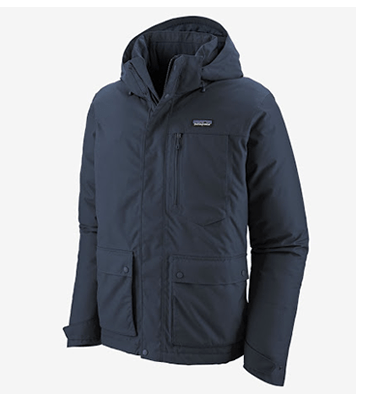
They really don’t cut corners. From simple stuff, like where to place the hand pockets, to the big stuff, like where to manufacture their products, you can trust that they’re doing it right.
And I’ve gotta say, it makes the brand incredibly easy to love.
You may agree. You may love, for example, that Patagonia is a 1% For The Planet member. (Like us at Grow Ensemble!). But did you know that Patagonia founder, Yvon Chouinard, was actually one of the people that started the 1% alliance?
Or maybe you appreciate that more than 65% of their products are made with recycled materials, leading efforts to reduce waste in order to save our oceans and our whole planet. Or that they have a Supply Chain Environmental Responsibility Program to measure and reduce the footprint of their corporation. But did you know that they’re aiming to be completely carbon neutral by 2025?
You might love their BLUESIGN approved fabrics. But did you know they were the very first brand to officially join as a BLUESIGN system partner?
You probably get the point, but I like to talk about it, so—Patagonia isn’t just keeping up with sustainability in their industry; they’re setting the pace for all companies fighting climate change (which is why we’ve included them as one of our favorite environmentally friendly companies out there).
That’s something to celebrate. I mean, so is the headphone compatibility in the Topley’s left-chest patch pocket. But that whole changing the world thing is pretty cool too.
The Good & Bad of Choosing Patagonia’s Topley Jacket
![]() PROS
PROS
- Highest standard of waterproof performance
- Highly breathable shell
- Excellent warmth-to-weight ratio
- Comfortable fit & urban style
![]() CONS
CONS
- High price point
- Requires layering for freezing temperatures
The Deets on the Jacket!
You might think that the technical review portion of this article would be my least favorite part to write, but in that you’d be wrong. Conversely, you might be thinking that it’s weird how fired up about the Topley’s jacket features I am. In that, you’d be right.
But.. I mean.. look at all of this.
H2No® Performance Standard Waterproof Shell:
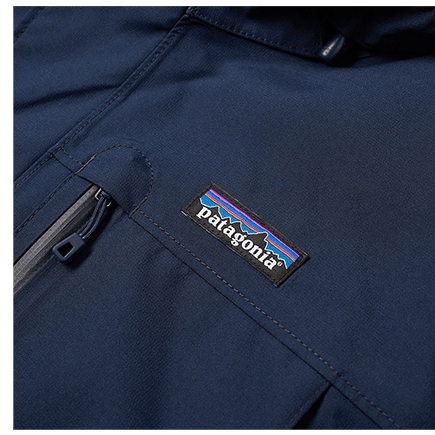
Ever had a jacket that claims to be waterproof but then is profoundly not waterproof? That’s my greatest gear pet peeve. Patagonia’s H2No® Performance Standard shell is the antithesis of that.
As Patagonia puts it, “The H₂No® Performance Standard is Patagonia’s benchmark for waterproofness, breathability and durability.” It’s been tested one million times, in a million different ways to ensure that it can endure any measure of wet and watering. Rain, snow, sleet, a cup of water for curiosity’s sake—the Topley handles them all with grace.
In other words; if you ever get trapped in a rainstorm, you’ll want to be wearing the Topley Jacket.
DWR (Durable Water Repellent) Finish:
Both the shell and the lining of the Topley enjoy the benefits of a DWR finish. As the acronym for durable water repellent, it isn’t hard to imagine what a DWR finish is intended to do.
It gives the “beading effect” to your waterproof jacket, causing water to roll off as if you were a duck emerging from a pond. Lesser known, DWR is also responsible for increasing the breathability of your waterproof shell.
With the Topley, both the shell and liner get the DWR treatment. The liner is even made with a progressive PFC-free DWR finish (re: a coating that does not contain perfluorinated chemistry) to ensure cleaner contact with the skin.
100% Recycled Down:
Duck down, goose down, synthetic down, virgin down, traceable down—there’s a lot to learn about the world of down. But with the Topley, it’s all pretty simple.
This insulated jacket is made with 100% recycled down. A sensible blend of duck and goose down from reclaimed down products, there is no virgin down to be found in the Topley. (Although if there was, it’d be certified to the Advanced Global Traceable Down standard, because that’s how just Patagonia does it.)
In terms of functionality, down is one of the most light, warm, compressible and durable insulators there is. It’s just another reason the Topley commands the price tag and the praise that it does.
Weather Proof Details:
You should know by now that if Patagonia claims a jacket to be warm, waterproof, and breathable, it’s going to be just that. To the upteenth degree. In so many ways, big and small, the Topley is here to prove them right. They’ve really looked at every detail through the lens of weather.
It’s stacked with smart features like a waterproof center zipper with secure snap closures on the external storm flap and side-entry handwarmer pockets with brushed jersey on the knuckle side. There’s a microfleece collar for greater comfort while you’re sealed up against the storm, and drawcord hem to lock out wind and rain.
Sealed Pockets:
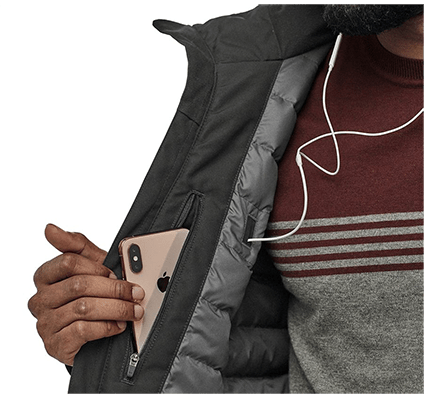
Although the side-entry handwarmer pockets are open, Patagonia added a few very sensible sealed pockets to the Topley to ensure that your valuables stay dry and protected.
The top-entry patch pockets feature two snap closures, the exterior chest pocket has a waterproof zipper and the interior pocket zips shut to hold in cash, your ID, or other small essentials.
By any standard, but especially as a men’s only style, the sealed pockets are an important addition. At least for Colton, who tends to shed his belongings like a molting snake, having a safe, secure place to keep your things is priceless.
What are the People Saying about Patagonia’s Topley Jacket?
Compared to some of Patagonia’s more common styles (hi, Nano Puff), the Topley Jacket doesn’t have a ton of chatter around the web—Topley wearers are probably too busy off fulfilling all of their outdoor adventure dreams to share the good news.
But what is there, is all good stuff:

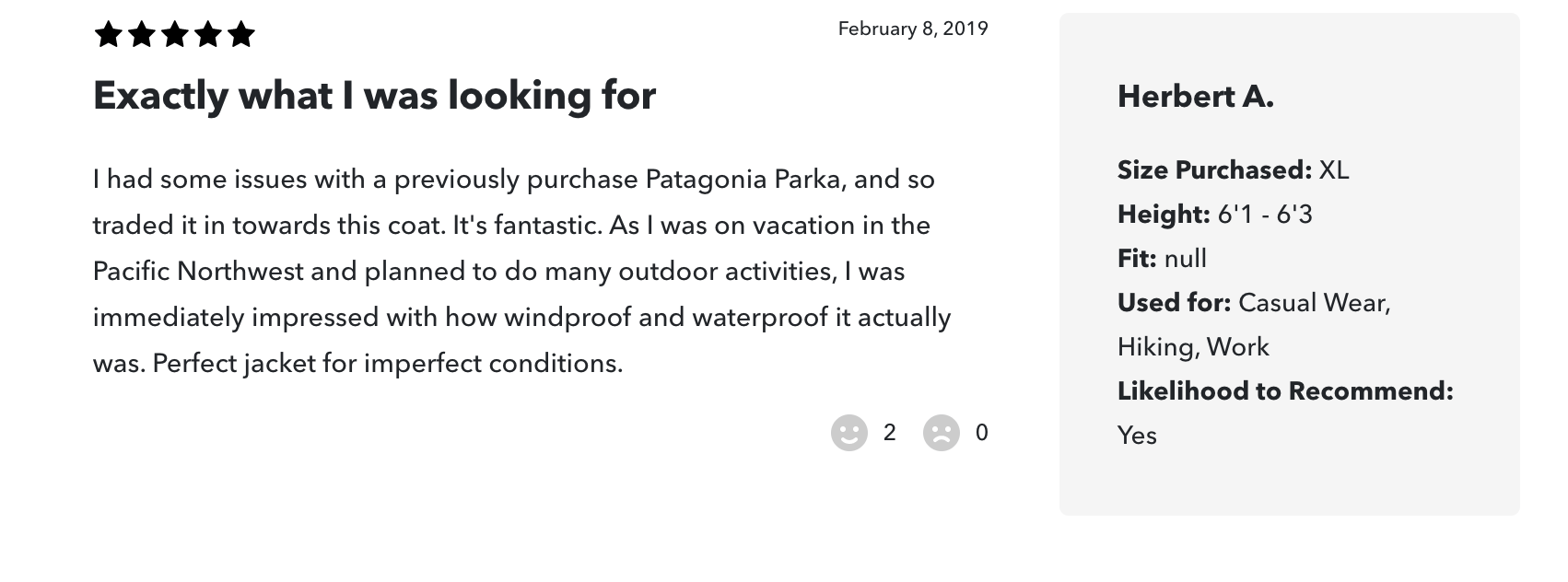
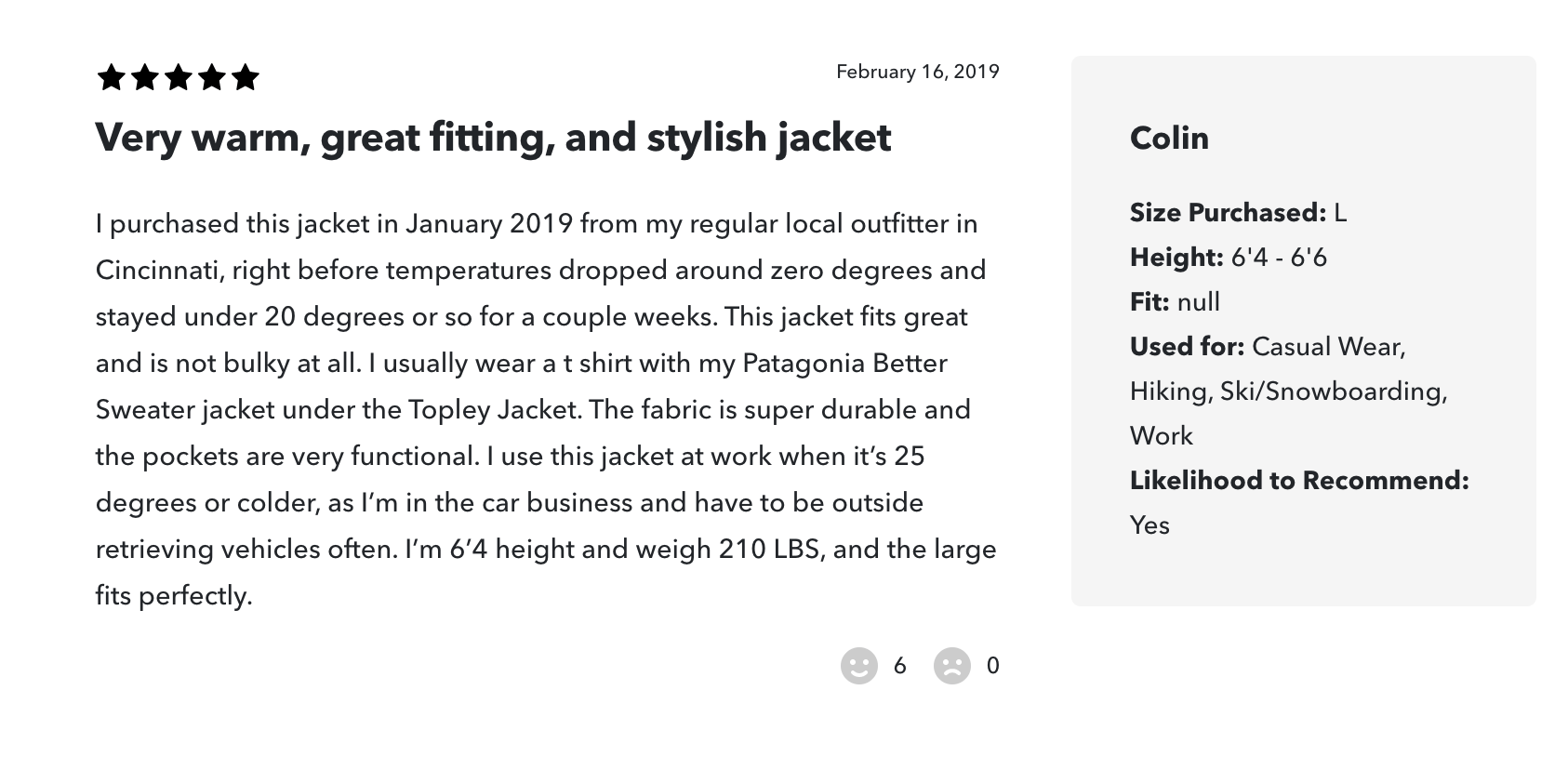
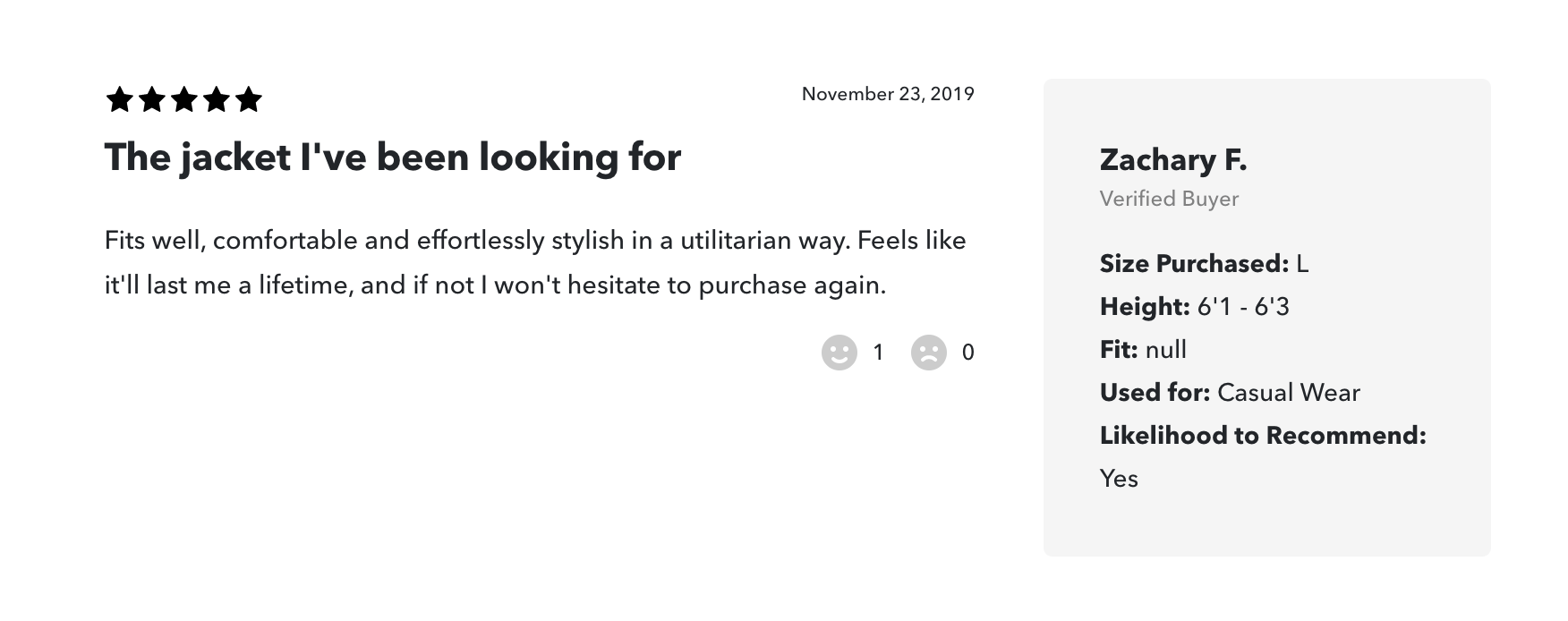
Still Not Convinced? Other Options to Explore… 🤔
Honestly, it’s kind of hard to find a jacket like the Topley. Down and waterproof don’t really go together, unless it’s done right. And rarely is it done right. While Patagonia has other popular jackets, none are quite like the Topley. Still, there’s a few solid options for those seeking a Topley alternative.
Marmot Oslo Jacket
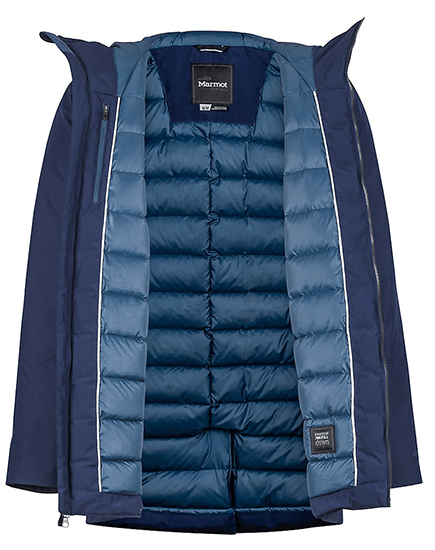
The Men’s Oslo Jacket from Marmot is one of the most similar products on the market. It’s got a 100% seam-taped, GORE-TEX shell protecting the 700-fill-power recycled down insulation interior. Handwarmer pockets, increased mobility through the arms—it’s a solid competitor to be sure. The main differences here are the style of the jacket and the sustainability credentials.
Rather than the hip length of the Topley, the Oslo Jacket rests at mid-thigh and sports a more outdoorsy look. And while Marmot is indeed BLUESIGN certified with recycled down, carbon reduction commitments, and PFC-free technologies, they’re not quite as eco-warrior forward as Patagonia. The cost is similar, running $425 versus the Topley’s $400.
The North Face Altier Down Triclimate Jacket

The Triclimate line from The North Face takes the down-and-waterproof combo of the Topley and Oslo and transforms it into a 3-in-1 jacket. You get a seam-sealed, waterproof and windproof shell with a removable 550-fill down goose down jacket.
You can rock just the waterproof shell, only the down jacket, or the hearty combination of the two. It shares some qualities with the Topley, like secure-zip pockets and the urban-friendly hip length, but shares the more outdoorsy, raincoat-esque style of the Oslo.
The North Face is also committed to BLUESIGN certified fabrics, recycled materials and offers lifetime warranty for all of their products. The Altier Down Triclimate is a little less expensive than the Topley at just $260.
Patagonia’s Topley Jacket is What We’ve Been Looking For
And with that, you now have everything you ever wanted to know about the Topley and probably a few things you never wanted to know about my husband. (He’s great, right?)
As this is technically his review and not mine, I’ll leave you with his final synopsis: “As a well-researched, frugal, and hard-wearing clothing person I would rate this jacket a 10 out of 10.”
From what I’ve seen, I’d have to agree. Patagonia does it again, folks.

Thanks for reading! You can take your sustainability journey further with our weekly newsletter. Each week, I share 1 meditation on the art of living & working sustainably. 7500+ people subscribe. Enter your email below to join in.

Rebecca Cruse
Grow Ensemble Contributor
Rebecca writes stuff from her home in South Lake Tahoe, CA. Whether it’s the outdoors or travel, ethical brands or local breweries, Rebecca is always excited to share stories about the things she loves.





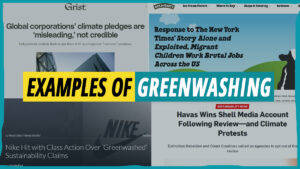


Okay, Rebecca, you’ve got me convinced. I’ll be ordering mine today. I live in Buffalo NY, and it sound like this jacket will be perfect for my needs. I do have a long LL Bean storm coat for when the snow simply won’t stop falling and the North winds are howling.
Thanks again, for your commentary!
Lowell,
Bingo – so glad you liked Becca’s write-up!
Cheers,
-Cory